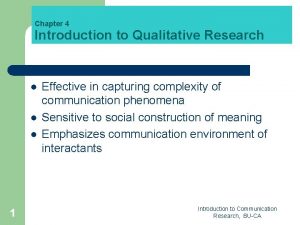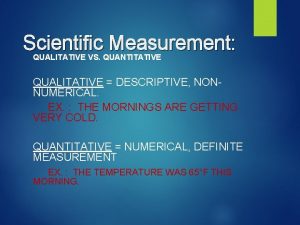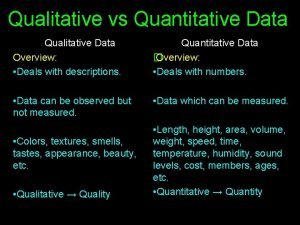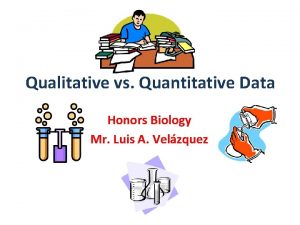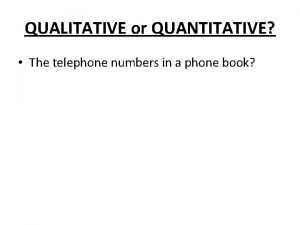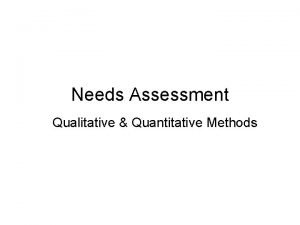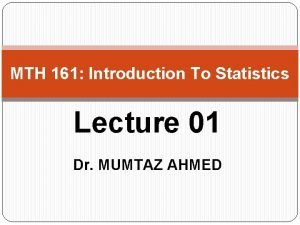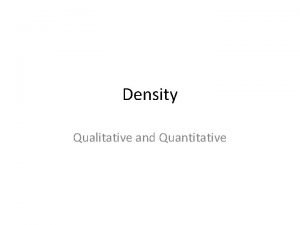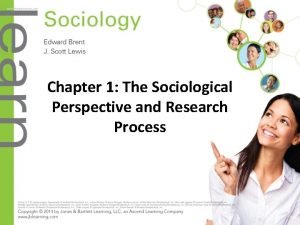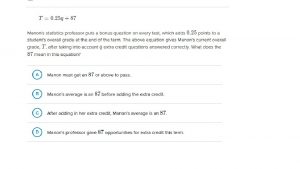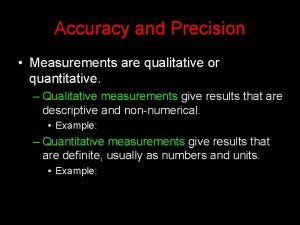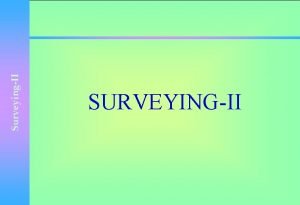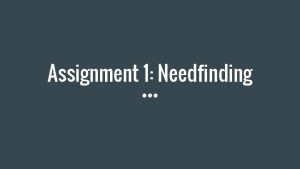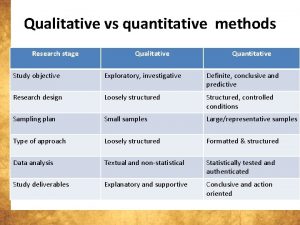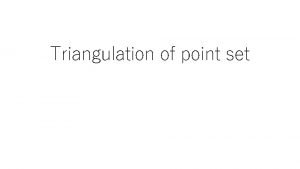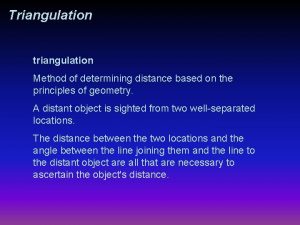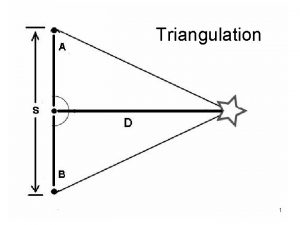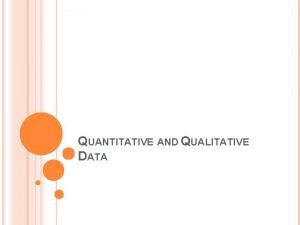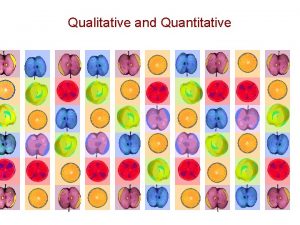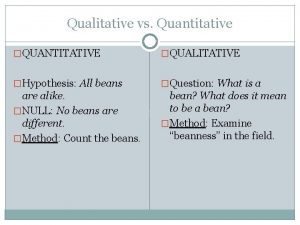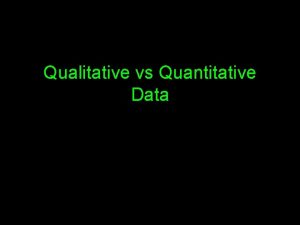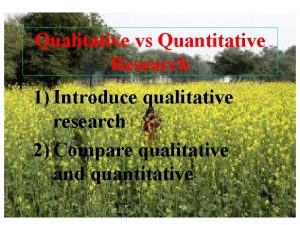Qualitative Research Needfinding Qualitative vs Quantitative Research Triangulation



























- Slides: 27

Qualitative Research / Needfinding

Qualitative vs. Quantitative Research • Triangulation - Collect data through diverse methods • Qualitative Methods – Examines the way people think and feel (subjective) and includes: • Observations, Interviews, focus groups, etc. • Quantitative Methods – Generates numerical data (objective) and can include: • Surveys, Laboratory experiments, etc. (we will learn more about this at the end of the semester)

Qualitative Method: Observation • Observation – Researcher should not be noticed – Immerse in the environment that he/she is observing

Fly on the Wall Observations • The “Fly on the Wall” (FOTW) technique is an unobtrusive observation technique where the observer has no interaction with the users. • The observer does not interfere. • With fly-on-the-wall observation you observe from a distance.

FOTW, cont. • Goals: – Gain familiarity with the social context being studied. – Observe interactions without influencing the social context. • Helpful in situations in which observations can affect user behavior. • Example: – If you are trying to observe workers, they may show increased productivity in your presence.

Qualitative Method: Interviews • Field Notes/Interviews - Researcher takes notes about the setting – Takes notes – Interviews people • Recommendation: Do not try to recreate dialogue. Take a tape recorder.

Guidelines to taking notes • Are there specific things that you would like to learn about? • Who were the actors present? (provide pseudonyms if necessary and some description) • What were the main issues or themes that struck you in this setting? • Were there specific issues that you might want to explore further?

Ethnography What is Ethnography? Ethnography is a qualitative orientation to research that emphasizes the detailed observation of people in naturally occurring settings. – Studying a group of people – Sharing cultural traits • practices, concepts, beliefs – Why a group does what it does

Ethnography, cont. • Take part in the life of people • Take place in natural setting of the subjects • Ethnographer must observe others and participate with them at the same time

Advantages of Ethnography • Provides a detailed picture of a particular situation. • Findings based on natural setting and lives of the people • Good for studies where the topic: – Is complex – And embedded in a social system that is not fully understood • Think of it as a study that will tell you “what to study quantitatively in the lab” or “what to build”

Disadvantages of Ethnography • High demands of the researcher • Not as well established as surveys/experiments. • Hard to reproduce findings to other areas

How to do an Ethnography • Observation • May include open-ended interview (no yes/no questions)

What is Needfinding? • Needfinding is watching and asking people to learn about their goals and values to be able to uncover user needs and opportunities for improvement. • Needfinding resembles ethnographic methods, by making observations and interviewing users, but needfinding leads to design imperatives and product solutions that meet real user needs.

Observing Participants • What do people do? • People are different – – Example: If creating a mobile bus app to figure out the best way to get somewhere, think about the activity • some may want efficiency • others may be concerned more with cost. • Observe them, then interview them.

Observe • Walmart asked users – “Would you like stores with less clutter in the aisle? ” • Answer yes, but not what people want – they lost money. • Wide gap between what users say they did, and what is observed. – Examples: • Ask people how long they were in a store and it is double what is actually observed. • Ask them what they bought and throw-ins may be forgotten Scott Klemmor hci-class. org

Interviewing Guidelines • Start in middle. People on top are self-conscious they are too invested. Speak to people in middle. • Questions that aren’t so good: – Is the daily update an important feature to you? Leading question – most people will say yes if asked if it’s important. – To learn about it observation may be effective – see if someone used it. Or log files to see. “I see from the log you never used the daily update, why is that? Tell me more? ” More open-ended – the more interesting the answer you get. Scott Klemmor hci-class. org

Interview: Good Questions • Avoid: – Asking what they do or want in hypothetical scenario. – “How often” – they will lie (Ex. how often exercise). Rather, make things concrete – “How much exercise this week” vs. “How much exercise in a typical week” – Avoid binary yes/no. Rather, use Open-Ended questions -Let them respond. • Let some silence happen and they will talk. • Example: Teaching – “Does anyone know the answer” then teacher answers. No reason to participate. Wait longer, a few more seconds and someone will chime in. Scott Klemmor hci-class. org

Interview: Bad Questions • Bad questions: – “What would you like in a tool? ” Users are only experts in their own lives not design. They won’t know what to say. Example: Horse and Buggy – what do you want? Faster horse. They don’t know about a car – designers do. Not users. Scott Klemmor hci-class. org

Designers vs. Users • Designer - comes up with design. • Users do not. • Though sometimes advanced users (aka lead users- as Eric von Kippel coined it) can help design with a creative solution. • Example: The first Skateboards and Skooters previously were made by children. – (Started with wooden boxes/boards with roller skate wheels)

Participatory Design • Participatory Design/Co-Design-an approach which actively involves users. Equal collaboration between user and designer.

Recruiting Participants – Who to observe/interview? • Get representatives of the target audience of the system. Participants who would be using it. – May be current users of the system. (Or perhaps your technology broadens who currently uses the system. )

Who to Observe/Interview • Example: Lecture support system. – Teacher, student, department administrator, or maybe parents. – Freshman and Ph. D. student – Domestic and international – In major / out of major – Stronger student / weaker student • Won’t have all but get different people from different groups. *from Scott Klemmor hci-class. org

Interviewing, cont. • You may not get exactly what you want but approximate. • Example: – System for doctors – may need to use medical students instead of doctors. – computer science students instead of software engineers. • Not ideal but better than nothing. *from Scott Klemmor hci-class. org

Find People to Interview • Finding Participants: – Reach out through friends and family – social network. Ask your sister who she knows, or friends of friends. – Pay participants: Craigslist $50 -$100. – Cheaper for less specialized users. – Cheaper if you say it will make world a better place – maybe even for free. – If it will be used for a profit, a participant will want to be paid. – Or token of appreciation – gift certificate. Scott Klemmor hci-class. org

Extreme users • Extreme users- what aspect of your design do you want to explore to an extreme. • Example: Email – – Extreme users get far more emails than the average user – thousands of messages a day. If you can help them, you can help anyone. – Or a person in a cabin who checks email once a month. *from Scott Klemmor hci-class. org

Personas • Keep in mind actual users throughout the design process. • Create Personas who represent a type of users. – include demographic information and their motivation. – Can even have a picture or photo. – Give them a name and background/occupation, hopes and dreams, they should have a story. • Can relate and have empathy to a persona who seems real. • This helps the design be coherent rather than scattered. Scott Klemmor hci-class. org

Process • Needfinding - what people say and do • Storyboard – focus on task not user interface • Prototype – extension of the storyboard without technical coding • Heuristic Evaluation – Evaluate the prototype. Expensive to constantly users (3 -5 experts) • Usability Testing – USERS! • Designing Experiments – How to run a design study.
 Words images objects qualitative or quantitative
Words images objects qualitative or quantitative Quantitative vs qualitative
Quantitative vs qualitative Similarities between qualitative and quantitative research
Similarities between qualitative and quantitative research Similarities between qualitative and quantitative research
Similarities between qualitative and quantitative research Random sampling method in quantitative research
Random sampling method in quantitative research Similarities of qualitative and quantitative research
Similarities of qualitative and quantitative research Quantitative emphasis
Quantitative emphasis Data analysis in research example qualitative
Data analysis in research example qualitative Qualitative data geography
Qualitative data geography Holistic qualitative research
Holistic qualitative research Longitudinal study qualitative or quantitative
Longitudinal study qualitative or quantitative Qualitative vs quantitative science
Qualitative vs quantitative science Qualitative vs quantitative data analysis
Qualitative vs quantitative data analysis Qualitative vs quantitative biology
Qualitative vs quantitative biology Telephone number is qualitative or quantitative
Telephone number is qualitative or quantitative Difference between qualitative and quantative data
Difference between qualitative and quantative data Quantitative vs qualitative observations
Quantitative vs qualitative observations Different between qualitative and quantitative
Different between qualitative and quantitative A qualitative variable
A qualitative variable Qualitative und quantitative differenzierung
Qualitative und quantitative differenzierung Is volume qualitative or quantitative
Is volume qualitative or quantitative Quantitative vs qualitative data collection
Quantitative vs qualitative data collection Qualitative vs quantitative sociology
Qualitative vs quantitative sociology Heights of hot air balloons qualitative or quantitative
Heights of hot air balloons qualitative or quantitative Quantitative and qualitative variables examples
Quantitative and qualitative variables examples Is accuracy qualitative or quantitative
Is accuracy qualitative or quantitative Words images objects qualitative or quantitative
Words images objects qualitative or quantitative Quantitative and qualitative traits
Quantitative and qualitative traits



